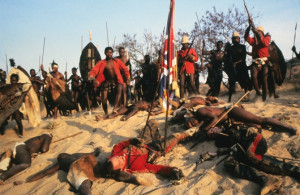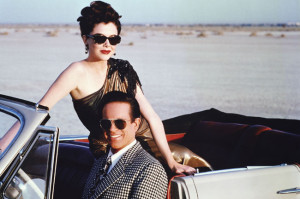
“BOARDWALK EMPIRE”: ECHOING JOHN WEBSTER
One of the flashbacks in the most recent episode of “BOARDWALK EMPIRE” featured a scene with the future Atlantic City crime lord, Jimmy Darmody, discussing the English dramatist John Webster’s 1612 play, “The White Devil” with his class at Princeton University. After watching the entire episode, it occurred to me that another one of Webster’s plays could have served as a reference.
I have never posted an article about an episode of “BOARDWALK EMPIRE” during these last two seasons. I have posted a gallery featuring images and a list of favorite episodes from Season One. But after watching (2.11) “Under God’s Power She Flourishes”, I realized that I could not keep my mouth shut. Or at least refrain from writing something about it. What can I say? It blew my mind. Even more so than the previous episode, (2.10) “Georgia Peaches”.

“Under God’s Power She Flourishes” featured the deterioration of the relationship between former Atlantic City political boss Nucky Thompson and his Irish-born mistress, Margaret Schroeder. Margaret has been sagging under the belief that her sins – both past and recent – led to divine retribution in the form of her daughter Emily being struck down by polio. Margaret had hoped that a financial contribution to the Catholic Church would lead God to alleviate her daughter’s pain. When that failed, she decided that the only way to satisfy God would be to consider testifying against Nucky, regarding the murder of her late husband, Hans Schroeder. Naturally, Nucky is both disturbed and greatly peeved by Margaret’s suggestion. He thought he had finally nipped in the bud the possibility of being convicted by the U.S. Department of Justice for Schroeder’s murder. Nucky and his attorney had learned from the former’s servant about Treasury Agent Nelson Van Alden’s murder of fellow colleague Agent Sebso back in Season One.
Like Margaret, Van Alden had hoped that his recent actions – turning over his files on Nucky to Federal prosecutor Esther Randolph, granting his wife a divorce and resisting Mickey Doyle’s suggestion that he raid a bootlegging operation ran by Charlie Luciano, Meyer Lansky and Al Capone in exchange for a bribe – would lead God to prevent him from any further suffering or encountering further retribution for his crimes and sins. Instead, Esther Randolph reminded him of Agent Sebso’s murder and Van Alden found himself a fugitive from Federal justice. Looking at Margaret and Van Alden’s hopes and disappointments, I cannot help but wonder if their idea of embracing God called for some kind of business deal for their safety or the safety of loved ones.
But the meat of “Under God’s Power She Flourishes” picked up several hours after “Georgia Peaches” ended. Angela Darmody, who had been murdered by Philadelphia mobster/butcher Manny Horvitz in retaliation for a murder attempt, was being carried away by a coroner’s truck. A sheriff deputy questioned mother-in-law Gillian Darmody and Richard Harrow on the whereabouts of Angela’s missing husband, Jimmy. Jimmy had traveled to Princeton to unload a supply of bootleg whiskey he was unable to sell in Atlantic City. The news of Angela’s death, some booze and Luciano’s sample of heroin led to Jimmy recalling his last days at Princeton, before he joined the U.S. Army to fight World War I.

I tried to recall other “BOARDWALK EMPIRE”episodes that had relied on flashbacks, but none came to mind. I have no opinion on the use of flashbacks one way or the other, as long as they manage to serve the episode or movie in question. The Princeton flashbacks certainly served this latest “BOARDWALK EMPIRE”episode, as far as I am concerned. The flashbacks explained a great deal about Jimmy’s character and especially his relationships with both his mother Gillian and Angela, who had been a waitress at a local cafe when she and Jimmy first became involved. Jimmy and Angela’s pre-marital affair led to son Tommy’s conception. The flashbacks also featured Gillian’s visit to Princeton, where she met Angela for the first time. It seemed pretty obvious that Gillian did not care for her son’s new lady love. I can only wonder if Gillian’s feelings toward Jimmy’s romance with Angela led her to do what she did that evening. It was bad enough that she had briefly become involved with Jimmy’s professor – the one with whom he discussed John Webster. But what she did later – seduce Jimmy into having sex with her – left my head spinning and the Internet buzzing over the incident. The night of incest between mother and son also led the latter to join the Army to escape facing their deed.
But Jimmy could not avoid facing Gillian forever. He eventually returned home to Atlantic City in order to work for Nucky and raise Tommy with Angela by his side. Jimmy also renewed his relationship with Gillian – without any sex being involved, thank goodness. Unfortunately, I suspect that incestuous night at Princeton had left its mark on Jimmy. It may have damaged his psyche considerably. And it may have also led him to make major mistakes such as joining Gillian and his father, former political boss Louis “the Commodore” Kaestner, to betray Nucky, his mentor. It led him to join forces with Luciano, Lansky and Capone, to form their own criminal organization. It, along with pressure from both Eli Thompson and Gillian, led him to organize an unsuccessful hit on Nucky. And it may have led him to commit his two biggest mistakes – welch on a $5,000 payment to Manny Horvitz and suggest that another gangster named Waxy Gordon kill the Philadelphia mobster/butcher. In the end, Angela ended up dead, Tommy motherless and Jimmy finally unable to hold back the memories of the Darmodys’ Princeton sexcapade.
But it got worse. Upon his return to Atlantic City in the present, Jimmy found Gillian crowing over Angela’s death. With her “rival” gone, I can only assume Gillian saw no need to hide her true feelings about the former “underweight waitress”. But her crowing only ignited rage within Jimmy and led him to strangle her. The timely and rather surprising intervention by the recovering Commodore saved Gillian’s life. But after stabbing Jimmy’s shoulder with an antique spear, Jimmy stabbed his father with a trench knife. Another surprise appeared out of the blue when Gillian, with flashing eyes and a sharp tone, barked at Jimmy to finish the job and kill his father. Which he did. Many fans have compared Jimmy to the mythical Greek tragic hero, Oedipus. But the latter never knew that the man he had killed and woman he married were his parents. Jimmy, probably to his everlasting regret, did not possess such a luxury. But the sight of Gillian carrying Tommy upstairs, while stating that the latter will grow someday, and reminding him of the location of her bedroom, seemed to have left Jimmy wondering if his life had made an even uglier turn.

As for poor Angela . . . did anyone mourn her? Gillian certainly did not. I believe Jimmy did. But his grief seemed to be entwined with guilt over the suspicion that he became involved with Angela for the wrong reasons. Tommy is not even aware that his mother is dead, thanks to Gillian’s lie about Angela departing for Paris for a bit of fun. The only one left is hitman Richard Harrow, whose brief and silent regard of Angela’s blood made it obviously clear – at least to me – that he will miss her friendship very much. She was the only one who was able to face his disfigurement and situation with an open mind that not even Jimmy completely possessed. But Richard proved that he still had Jimmy’s back, when he got rid of the Commodore’s body on behalf of his friend.
Jimmy and Gillian’s night of incest was shocking, but not really surprising. The series has hinted an incestuous vibe between them since the series’ second episode, (1.02) “The Ivory Tower”. In this episode, Jimmy finally revealed his return from the Army to Gillian, when he greeted her with a present, backstage at the at the Cafe Beaux-Arts nightclub. I still recall that moment when the two first laid eyes upon each other. A scantily-clad Gillian jumped into his arms and rained kisses on his face before admonishing him for not writing. Jimmy eventually asked her to put some clothes on and handed her a present – a necklace. At first, I thought Gillian was another girlfriend that he kept a secret from Angela. But when he called her “Mom”, I found myself in complete shock. What mother would greet her grown son in a scantily-clad costume, by jumping into his arms before wrapping her legs around him? That was the first of many weird moments between Jimmy and Gillian that eventually escalated into that mind-blowing flashback. Some viewers and critics are complaining that the incest came unexpectedly and out of right field. Frankly, I believe they were not paying close attention to the relationship between mother and son.
One of the ironies about the episode is that “Under God’s Power She Flourishes” is the motto of Princeton University, the site of Jimmy and Gillian’s night of infamy. However, the biggest irony for me turned out to be the Commodore’s death. I found it interesting that his death came from his attempt to act as an aging knight-in-armor for Gillian, the very woman he had raped when she was 12 or 13 years-old. In a twisted way, the Commodore’s necrophiliac tendencies ended up costing him his life, a quarter of a century later. I did find myself wondering why the Commodore had attempted to save Gillian’s life in the first place. Had he grown fond of her during those last months with her and Jimmy in his home? Or did Gillian’s bitter recollection of the rape finally brought forth some form of guilt on his mind? I guess we will never know.
And how did John Webster fit into all of this? Jimmy’s discussion with his professor about the dramatist’s “The White Devil” and the latter’s drunken entanglements with the visiting Gillian led to a declaration that Jimmy’s life was one Jacobean saga. Webster’s tales involved a great deal of tragedy, corruption, murder . . . well, you get the picture. Even the topic of incest had made its way into Webster’s works – especially in his 1612-13 play, “The Duchess of Malfi”. In that story, the female lead, the Duchess of Malfi, was murdered by her two brothers – in which one of them harbored incestuous feelings for her – after she married beneath her class. Well, the only person Jimmy murdered was the Commodore. But I find it rather interesting that Jimmy and Gillian’s incestuous tryst inadvertently led to the Commodore’s death.
Some people have expressed fears that the Season Two finale will never be able to top this episode. Frankly, I also rather doubt it will. “Under God’s Power She Flourishes” struck me as one of those episodes that many will remember for years to come. I really do not see how (2.12) “To the Lost” will be able even better. I do not see how any episode could top “Under God’s Power She Flourishes” so soon. Then again, I had no idea that Terence Winter and his writers would top a first-rate episode like “Georgia Peaches” with the next one. In the end, I can only hope that the Season Two finale would end up being entertaining and interesting in the long run.
Filed under: Essay | Tagged: aleksa palladino, boardwalk empire, dabney coleman, early 20th century, gretchen mol, jack huston, john webster, kelly macdonald, literary, mark wahlberg, martin scorsese, michael pitt, michael shannon, politics, progressive era, prohibition, religion, shea whigham, stephen graham, steve buscemi, television, william forsythe, world war 1 | 1 Comment »




























































